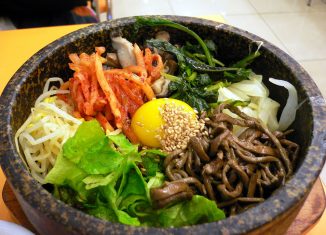
South Korea might be a small country, but what it lacks in size it makes up for a hundred-fold in flavors. A trip to South Korea is one of the most delightful experiences one can have. In the capital of Seoul, you’ll find modern conveniences nestled right alongside ancient palaces, stunning mountain backdrops, and intensely delicious food that is unlike anything else in the world.
When going out for Korean food, you’ll be absolutely delighted by banchan, the complimentary side dishes that come with your meal and are refilled at your request. It makes dining out in South Korea one of the best dining experiences you’ll ever have whether you’re dining in a casual place or one of the most refined restaurants in the city.
Without further ado, here is a list of 33 Korean dishes that you should not leave the country without trying.
1. Bibimbap

Bibimbap is incredibly fun to say, and it’s plenty of fun to eat too. It comes arranged all beautifully in a bowl (dolsot) of varying colors. Bibimbap literally means “mixed rice.” It consists of a bowl of warm white rice prepared in cooker that’s topped with sautéed seasoned vegetables (namul) and Korea’s famous chili pepper paste (gochujang). You’ll often find it with a raw egg on top (it gets cooked by the hot bowl) or sometimes the egg will be served to you fried, plus sliced beef. Just before eating this gorgeous creation, you’re supposed to stir it together to blend all the flavors together. In Korea, this is one of the most popular dishes, and for good reason. It is flawless!
2. Korean BBQ

When in Korea, do as the Koreans do. Have Korean BBQ. It’s so vastly different from the backyard barbecues you’re used to in America. For starters, Korean BBQ restaurants all come with tables that have individual grills on them as well as special ventilation that you can pull closer to suck up the excess smoke from the grill to keep the air clean. For Korean BBQ, there are many tasty options to grill up on your personal grill. One of them is kalbi (sometimes called galbi). Kalbi is short ribs that are marinated in a sweetened soy sauce. Because each family has their own special recipe, it varies a little from place to place, but everywhere you go, you’re guaranteed to have a delicious kalbi experience.
Samgyeopsal is another Korean BBQ favorite. It’s pork belly, and boy is it fantastic! Both kalbi and samgyeopsal are served with a variety of leafy vegetables for wrapping. Ideally, you order a side of rice to accompany it. Then you take your freshly grilled meats, dip them in one of the sauces like ssamjang (a bean paste) or sesame oil, and then wrap it up in lettuce with kimchi from your banchan array and rice. It satisfies flavor and texture desires for your palate in the most sublime of ways.
Additionally, Korean BBQ is great to enjoy with a group of friends. Take your time grilling your choice of meats and drink plenty of beer or soju (Korea’s answer to vodka) with it when you do!
3. Fried chicken

Fried chicken is crazy popular in Korea. Sure, you can get it in America, but it’s different. It’s crispier in Korea, much thanks to their habit of double frying it. The coating is thinner too and that thin, crispy crunch surrounding juicy chicken meat is unbeatable. You also have the option of getting it in a sweet sauce. So it’s crispy, juicy, and sweet all at once. It goes great with cold beer. Korean beers like Hite and Cass really hit the spot with fried chicken.
4. Jajangmyeon

Every culture has its own comfort food and for Koreans, that food is jajangmyeon. It is to Koreans what mac and cheese is to Americans. Jajangmyeon is the Korean version of Chinese food. It consists of noodles slathered in a thick, black soybean paste sauce. It has chunks of pork and vegetables in it and is incredibly satisfying.
5. Mul naengmyeon

If you visit Korea in the summertime, you’ll definitely want a nice big bowl of mul naengmyeon. It is a cold noodle dish, often served with ice in it to keep it perfectly chilled. The noodles are long and hand-made from buckwheat. Most restaurants come with cooking scissors on your table so you can cut the noodles in half so it’s easier to get a handle on them with your chopsticks. The broth is a little sweet and a lot tangy, served up in a large metal bowl. It comes topped off with cucumbers, pickled radish, and a hard-boiled egg. There are typically condiments on the table like vinegar and hot mustard that you can add to tailor it to your tastes but it’s pretty perfect the way it is.
6. Tteokbokki

Tteokbokki is a popular street food of spicy rice cakes. They aren’t like the kind of rice cakes we know in America. They are glutinous rice cakes so they’re firm yet chewy. They get decked out in a sauce of gochujang along with some onions, fishcakes and other vegetables. Nothing is better on a cold day than a steaming portion of tteokbokki. They make for a fantastic snack while you’re wandering around, or they can be enjoyed as a meal. Often the best places to nab them are near the subway entrances of Seoul where you’ll find vendors tucked away in big red tents. You can sit inside and enjoy them there or take them to go.
7. Pajeon

Pajeon is a type of savory pancake made with flour and eggs. It features plenty of pa, green onion. You’ll find it in other varieties including with squid, shrimp, and other tasty delights. Koreans particularly love to eat pajeon on rainy days with plenty of makkeoli, a Korean rice wine that is traditionally drank from a small bowl.
8. Sundae

Sundae is a Korean blood sausage. Pig intestines are stuffed with a mixture of blood and rice. It might not sound very appetizing but it is a beloved dish of the Koreans. You can also find it alongside tteokbokki in the red tents near the subway stations. It’s a bit chewy and soft with a rather robust earthy taste. It’s not everyone’s cup of tea but it’s definitely worth a try.
9. Jeonbokjuk

Juk is the porridge of Korea. They have a variety of juk and on a cold, snowy day, nothing will satisfy your soul quite like a bowl of it, particularly jeonbokjuk which is made with abalone. It’s very simple but intensely warming and soothing. It also happens to be very healthy.
10. Kimbap

Kimbap is Korea’s version of sushi. It comes in a ton of varieties, but the most common items you’ll find wrapped up inside them are imitation crab, pickled radish, fishcakes, and cooked egg. You’ll also see it with Spam, tuna fish, and cheese. It’s a great cheap eat too, one you can grab just about anywhere, even in the convenience stores.
11. Bulgogi

Another Korean dish that is world renowned now is bulgogi. It’s incredibly tender beef that has been marinated in a sauce of sweet and tangy flavors. It can be cooked on the grill though you’ll often find it cooked in a pan with onions and other vegetables. The sauce is unbeatable, especially when you pour it atop your little metal bowl of rice.
12. Kimchi

Technically, it’s considered part of the banchan, but Korea is famous for kimchi, a fermented cabbage. It complements every meal you’ll ever be served there and it’s important to get to know it and love it. Koreans are extremely passionate about kimchi. The flavors of it will vary from place to place, but you’ll love it tucked in with your Korean BBQ lettuce wraps or even simply with rice. Traditionally, it was prepared and stored in large jars underground to keep it cool during the winter. Today, many kitchens come equipped with a special kimchi storage area in the refrigerator or even have a separate refrigerated unit just for this purpose. The variety of kimchi is astounding with the most common type made from cabbage, however you’ll find it made with radishes, scallions, garlic, or even cucumber as the main vegetable.
13. Japchae

Japchae is a dish made from sweet potato noodles. They are stir-fried in sesame oil with thinly sliced vegetables like carrots, onions, mushrooms, and spinach. Often you’ll find beef in there too. Soy sauce with a hint of sugar comprises the sauce. Sesame seeds top it all off. You’ll find it served hot or cold. It’s good either way. When it is served on top of rice, it’s called japchaebap (bap means rice).
14. Kalguksu
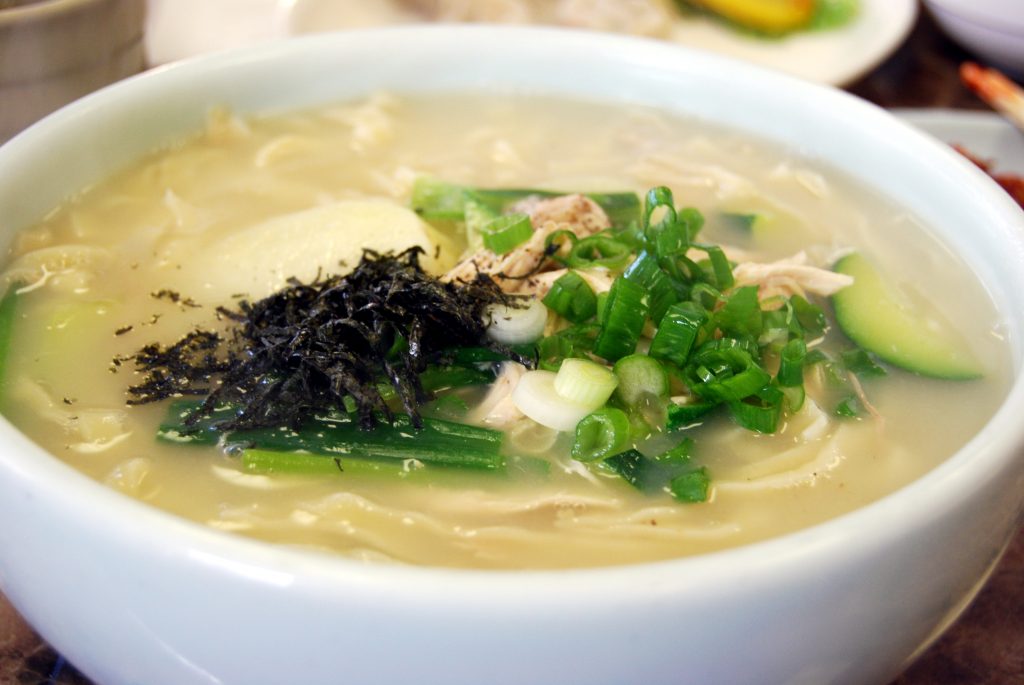
The name of this dish, kalguksu, means “knife noodles.” The noodles you’ll find within this basic dish are thick and cut by knives. Kalguksu can be tricky simply because if it’s not done right, you’ll be put off by anyone’s suggestion of going out for it. On the other hand, if you go to the right place, you’ll find it to be a heavenly and satisfying dish, often containing mushrooms, seafood or chicken along with the broth and noodles.
15. Mandu

Korean dumplings are called mandu, and you’re going to love them. They come in steamed, fried, and grilled varieties and the fillings are typically of minced meat and green onions. You’ll also find them filled with kimchi, an amazing creation you simply must try. Wang mandu are gigantic dumplings that you can grab on the go. One big one is perfect for a snack on the frigid walk to the subway.
16. Budae jigae (Army Stew)

After the Korean War was over, the Koreans were rather industrious with the leftover Spam and canned sausages from the army base rations. They incorporated it into a soup made with chili paste, tossed in some ramyeon (Korean instant noodles), glutinous rice cakes and slices of cheese. The result is a thick, slightly cheesy and fairly spicy hodgepodge of East meets West mingling in one bowl.
17. Ganjang gejang

The name is definitely fun to say in Korean. Ganjang gejang is raw blue crab marinated in soy sauce. Highly addictive and incredibly tasty, once you crunch into these gingery, garlicky, marinated crabs, there will be no stopping you.
18. Seolleongtang

Seolleongtang is actually a dish from Seoul. It’s an ox bone soup, which is as nourishing as it is satisfying and delicious. Americans are just now getting wind of the benefits of bone broth, but Koreans have long known the anti-aging and anti-inflammatory benefits of eating soups like this. It’s so simple yet so flavorful. The milky white cloudy broth is home to the textured bites of meat contained within. Great with rice on the coldest winter days, seolleongtang will warm up your chilly bones!
19. Soondubu jiggae

This spicy tofu stew is always served in a large stone bowl. You’ll find it with other vegetables, seafood, beef, or pork as well. The tofu (dubu) is the star of the dish, absorbing all the flavors of the other ingredients, particularly that addictive spice. It varies by region, but most often you will find it topped with a raw egg right before serving. The egg gets mixed into the soup and then served to you for an added bit of flavor.
20. Samgyetang
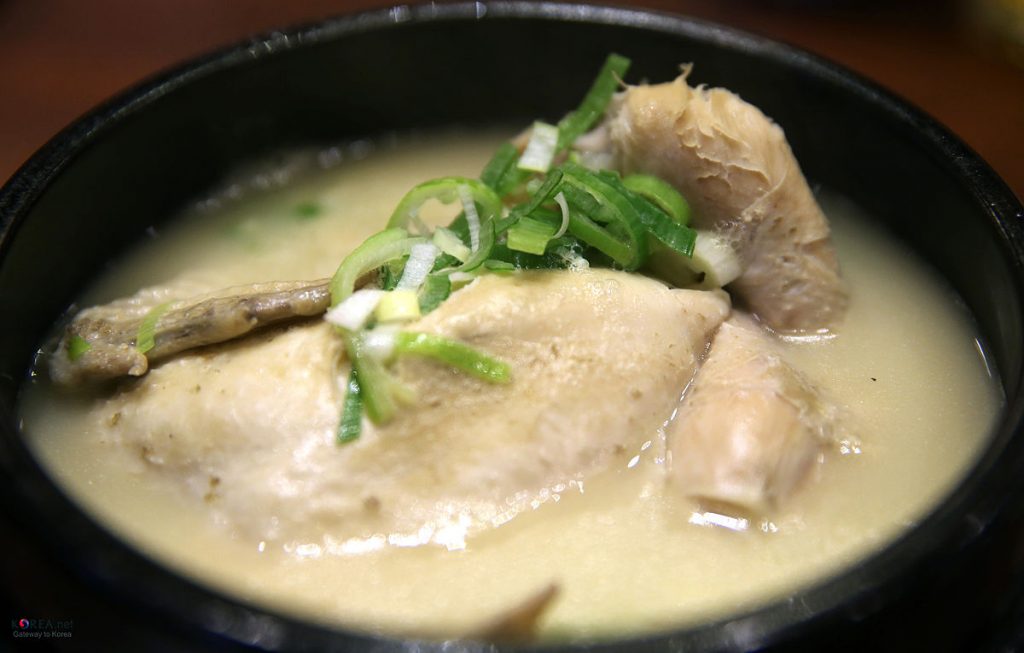
You cannot go to Korea in the summer without being taken out for samgyetang by your Korean friends. It’s considered one of the healthiest options. It is a very traditional Korean soup made with a whole chicken, garlic, rice, scallions, ginseng, jujube and spices. If you’re feeling under the weather, this soup will definitely set you right again.
21. Kamjatang

Kamjatang (or gamjatang) literally translates to potato soup. It’s hearty and robust. You’ll find kamjatang 24 hours a day because Koreans enjoy eating it after a night of drinking. Give it a try after you spend all night wandering the streets of Itaewon drinking with your friends.
22. Doenjang jjigae

This stew might just be Korea’s most favorite dishes. It’s a very simple stew made with tofu, mushrooms, doenjang, scallions, green peppers, and a couple anchovies thrown in for good measure. The distinctive taste comes from the slightly fishy flavors of the anchovies but that is exactly what gives it such flair.
23. Bossam

Quite simply, bossam is steamed pork. It’s served with leaves of lettuce, perilla, and kimchi along with dipping sauces. Ssamjang is the spicy chili paste sauce mixed with doenjang, the salty soybean paste. Saujeot is a pink and salty sauce made pickled little shrimp. To properly enjoy, wrap up the bossam and dip in the sauces. Yum!
24. Kyeranjjim

Technically a side dish, you have to order it whenever you’re eating something spicy. It’s basically an egg soufflé and it is incredible. An egg is beaten and lightly salted, then steamed in a bowl until it turned into a heavenly soufflé-like texture. It’s flavored with sesame oil and usually has sesame seeds garnished on the top.
25. Nakji bokkeum

If you love spicy, do not miss out on nakji bokkeum. It’s a dish of stir-fried octopus mixed with udon noodles. The sauce of spicy red pepper will set your mouth on fire but the with the slightly chewy texture of the octopus, it is tasty spectacle your mouth needs to experience.
26. Eomuk

Eomuk are deep-fried fish cakes. You can find them alongside the roads and in all the subway stations. You’ll usually find them wherever tteokbokki is sold. They have a spongy texture and while they seem unusual, one bite and you’ll be grabbing one of these every time you run through the Seoul Metro stations.
27. Bingsu

Every culture loves ice cream, especially Koreans. They have plenty of delicious ice cream treats in the stores (all for insanely cheap prices too) but the one thing Koreans love even more is bingsu. It’s a shaved ice dessert that comes adorned with toppings like mocha, matcha, and the favorite of Koreans, red bean paste. It’s perfect for a hot summer day.
28. Songpyeon
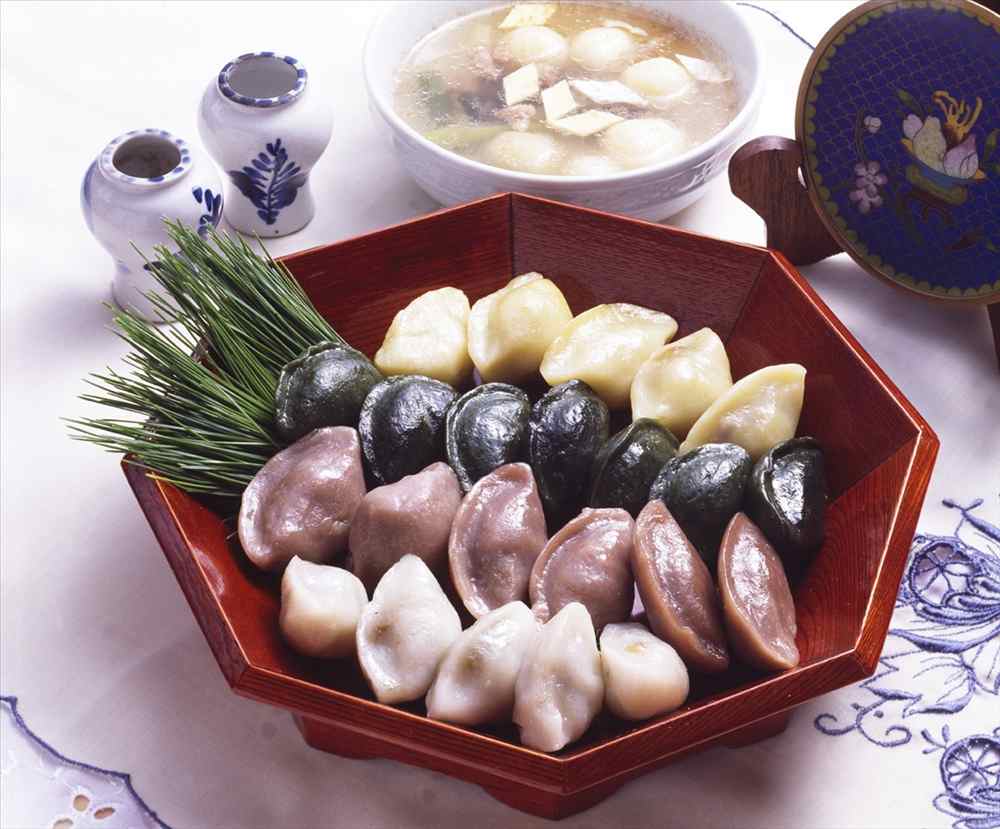
Visit Korea in the fall and you’ll hopefully have a chance to take part in some Chuseok traditions. Chuseok is a fall harvest holiday, a bit similar to what we celebrate as Thanksgiving in America. Songpyeon are glutinous rice cakes filled with sweet fillings like chestnut paste.
29. Ramyeon

If you like instant noodles, you’ll love the Korean version called ramyeon. The noodles are curlier and thinner than the Japanese versions of instant noodles. There are tons of ramyeon restaurants around Seoul. Pop in for a hot bowl to warm up after walking around all day. There are tons of varieties including kimchi ramyeon.
30. Sannakji

When in Korea, do as the Koreans do. Order sannakji. It is small octopus that is cut up into smaller pieces and served raw while the tentacles still squirm. It sounds horrible, but the textural satisfaction of eating this is sensational. Just one small warning – be careful not to choke because the suction cups will cling to your tongue to save themselves.
31. Kimchi bokkeumbap

If you tried kimchi and felt it was just too strong for you, try kimchi bokkeumbap and you might just be pleasantly surprised. Because it’s mixed with rice, pork, and other vegetables, it mellows out the strong kimchi taste and takes it to a whole new level.
32. Jeyukdeopbap
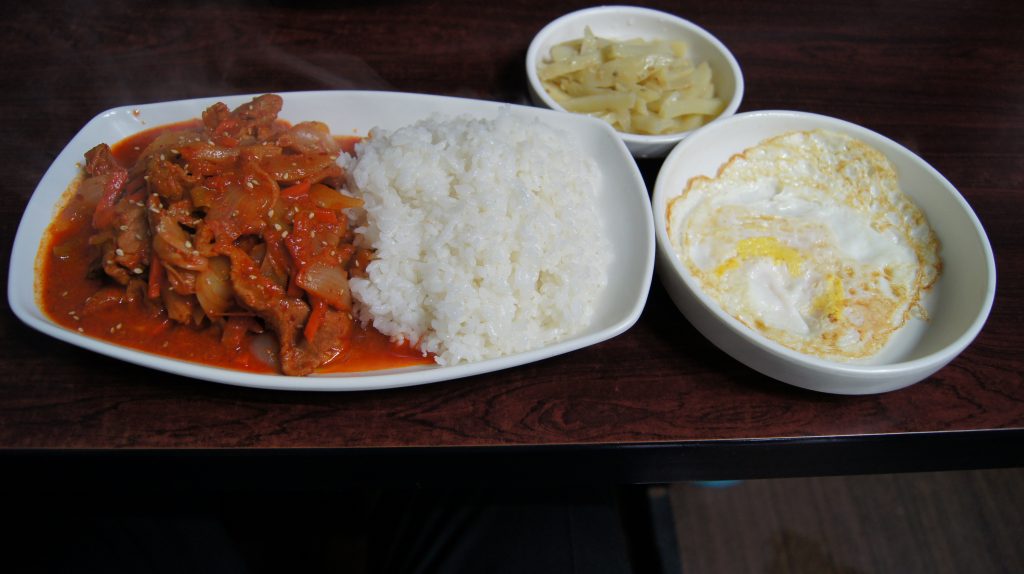
This thinly sliced pork dish is marinated in a red sauce that looks spicy. But looks can be deceiving. It’s more salty than anything and wonderfully satiating.
33. Kim (or Gim)

In many places in Korea, you’ll be served kim along with your rice and your meal. Kim (or gim) are toasted, salted squares of seaweed. They are a staple in every Korean household and once you try them, you’ll want them in your house for snacking too. You can enjoy them as-is or stuff them with rice. Add in bits of kimchi and meat for the perfect vessel to enjoy any Korean dish.
The bright and wonderful flavors of Korea await you. Some of the best restaurants are in Seoul. If you have Korean friends, they’ll be happy to give you great recommendations of where to eat, or the concierge at your hotel can help you find highly-regarded restaurants to dine in.
__________________________
We spent a lot of time researching and writing this article. If you think it’s valuable – please share link to this article on your Social Media or Website. Thx a lot!

